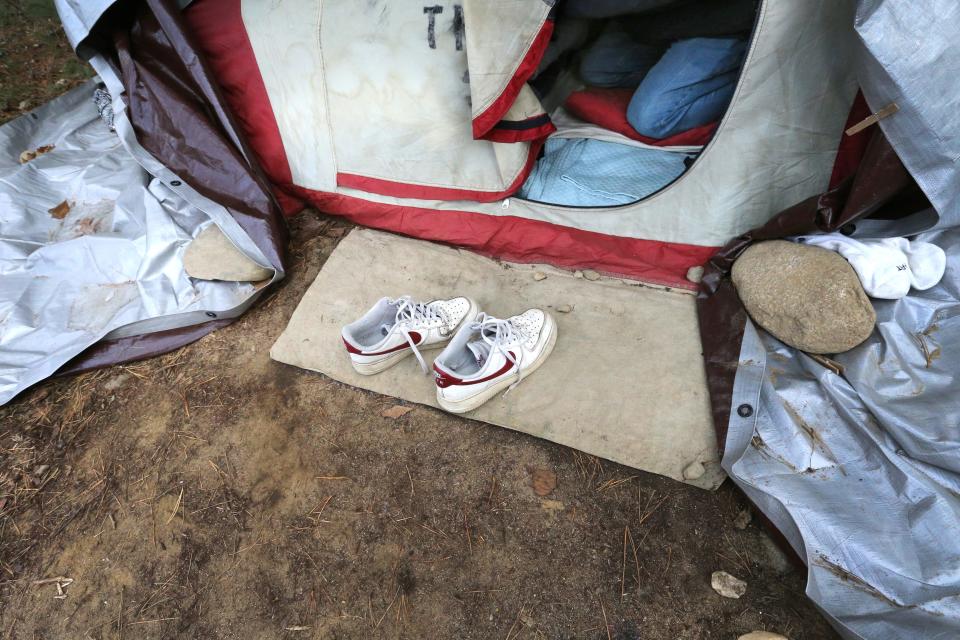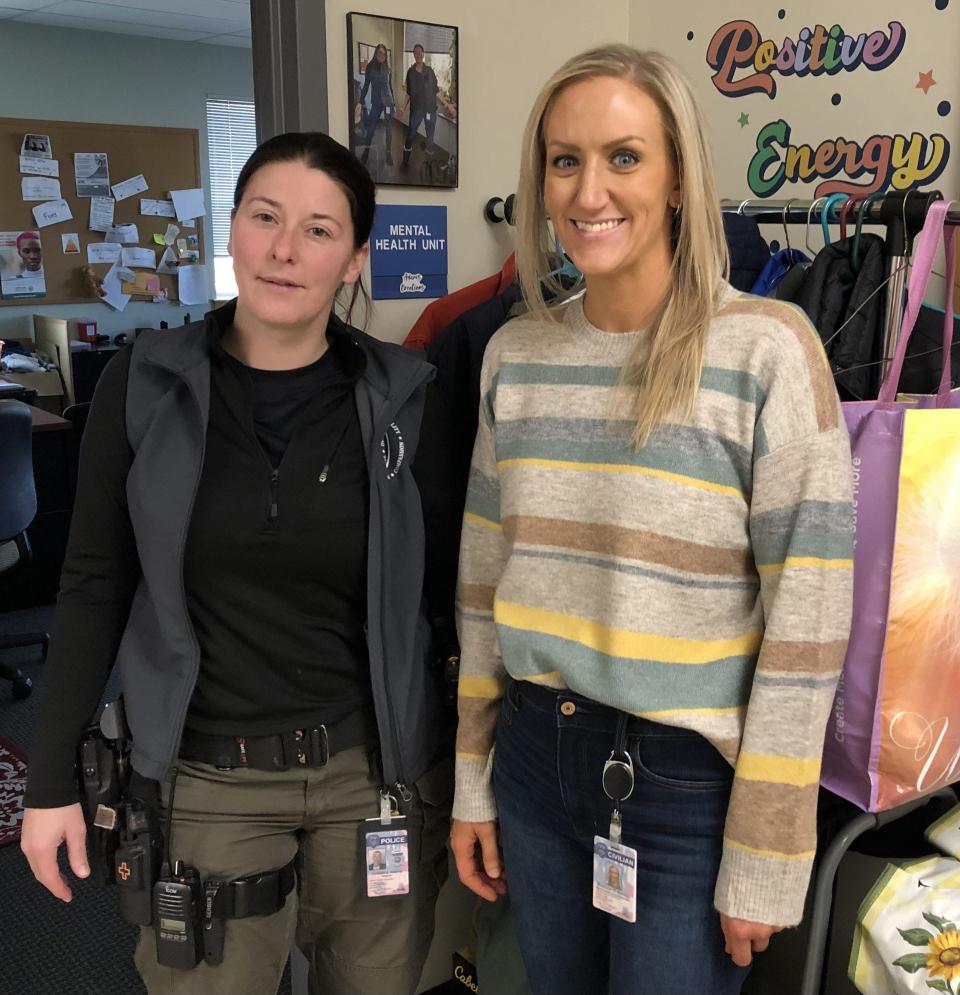Sanford homeless crisis: How city police's Mental Health Unit is helping hundreds in need
SANFORD, Maine — Last year at around this time, approximately 40 people were identified as homeless in Sanford, according to police Maj. Matthew Gagne.
And now? The number is more than 200, and the three members of the Sanford Police Department’s Mental Health Unit are doing all they can to help as many as they can.
People from all walks of life are finding themselves homeless, according to Sgt. Colleen Adams, who heads the unit as its community outreach coordinator.
“We have elderly people outside,” she said. “We have people with severe medical issues. We have kids who are outside. We have people who are working jobs but can’t afford an apartment.”

Formed in 2021, the Sanford PD’s Mental Health Unit is dedicated to providing aid and resources for those who are experiencing homelessness and also those who are grappling with substance use disorder or a mental health crisis.
In addition to Adams, the unit is comprised of Shannon Bentley, who is its mental health first responder, and Lacey Bailey, who is an overdose-prevention clinician. Another police officer likely will join the unit as a fourth member in January, according to Adams.
Adams confirmed there are 203 known unhoused individuals in Sanford. According to Adams, the reasons for the high number are many.
For starters, federal funding to help people find temporary shelter during the COVID-19 pandemic ended earlier this year.
“Right around the end of winter, you had all of these people coming out of hotels to no available housing,” Adams said.
Also, evictions are “going through the roof,” Adams added, and the high average cost of monthly rent, along with an expected down payment, is keeping people of limited financial means out of new places to call home.
According to the unit’s own research, the fair market value of a single-bedroom apartment in Sanford, with utilities included, is $1,136 in rent per month. Adams said she and her colleagues looked at the rent of local apartments on Zillow and Craigslist online and could not find any offerings in that price range.
Social Security income is minimal and housing prices are “outrageous,” Bentley said, and available beds at the York County Shelter Programs in Alfred are few.
“We have 36 shelter beds, total, for the county,” Bentley said.
This past summer, local unhoused individuals were more visible than ever to the public, for they had no place to spend their days when the peer center on Washington Street closed and relocated to Biddeford, according to Adams. Homeless people could be seen gathering in groups in Central Park in the downtown.
The closing of the peer center has “really been a hit to our community,” Bentley added.
More: How York County plans to fight the opioid crisis with a comprehensive recovery facility
What Sanford is doing to help the unhoused
On Dec. 1, the city opened a new warming center at the former Lafayette School on Brook Street. Given codes, a warming center is different from a shelter, Adams noted. A shelter provides beds. A warming center is precisely that: a place to come in out of the cold.
More than 20 people at a time will be able to be inside the warming center, but they cannot be on a bed, according to Adams. Instead, they can recline in gravity chairs. Adams added that the maximum capacity of guests at the warming center could rise to more than 40 in 2024, if funding for more of those gravity chairs comes through.
On Monday, Dec. 11, the city held a summit about homelessness that included state legislators, members of the county government, and municipal officials from Sanford and other communities.
“This isn’t just a Sanford problem,” Adams said. “Not a Biddeford problem. A Portland problem. This is a countywide issue.”
And, in all cases, the unhoused want to be considered as members of the community, Adams and Bentley said.

“That’s a huge piece of it,” Bentley said. “They feel the stigma and the judgment. They want people to look at them like any other citizen from this area. They’re our community members. They’re our neighbors.”
Tragedy in Sanford: Homeless man dies in tent fire, cause under investigation
50% of people are 'one step away from homelessness'
Bentley mentioned a United Way survey showing that nearly 50% of people in the area are “just one step away from homelessness.” All it can take is one lost job, one injury, one unfortunate twist in one’s life, she added.
More low-barrier shelters, or ones with less stringent qualifications for entry, are needed, according to Adams.
Housing First models also are needed, Adams added.
According to the National Alliance to End Homelessness, Housing First is an approach that “prioritizes providing permanent housing to people experiencing homelessness.”
The model involves the homeless individual in choosing their home, in the belief that such empowerment will make the person more successful in remaining housed and improving their life. To help ensure such success, individuals can have a case manager to whom they can turn and also have peer support and counseling in such matters as mental health, substance use, finances, and more.
“The thing about Housing First that’s really important is that it takes away the things that would typically get a tenant evicted, and it adds that into expected behaviors for this population,” Bentley said.
Bentley also called for much more funding for the state’s mental health system. She said psychiatric beds are needed. She added that Maine must do more to attract providers. As well, she said, reimbursement rates from insurance companies need to go up, so that providers are willing to take insurance and treat more people.
“We need our whole mental health system to be doubled in budget,” Bentley said. “We desperately need it because our system is crumbling.”
In the meantime, community support remains important, according to Adams and Bentley. Residents can donate goods to the Sanford Food Pantry at 1204 Main St. Residents also can donate gift cards and clothing by bringing them to the Sanford Police Department, to the Mental Health Unit’s attention. More businesses and organizations can do what some, such as Frannie’s Donuts and the Sanford Housing Authority, already are doing: serving free meals once or twice a week.
This article originally appeared on Portsmouth Herald: Homeless in Sanford ME: How city responds to surge of homelessness

